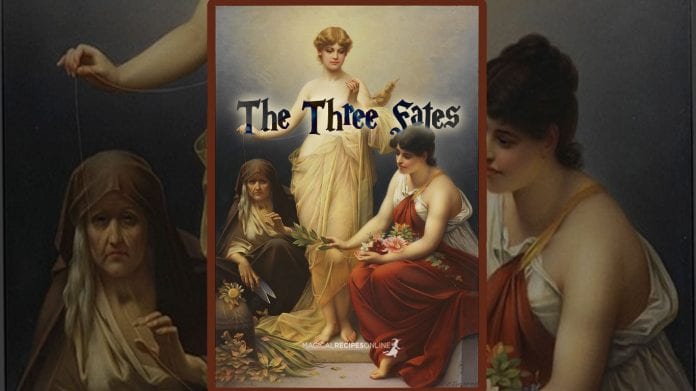What will my Fate has commanded for my Life? A question asked by many – if not all – of us, at some point of our lives. Our Ancients believed that there are indeed three Deities responsible for our destiny. Moirae in ancient Greece, Fates in Roman Empire and Norns in the Norse mythology. Lets see who they are. Let’s Begin with the latest Norns, the three fates of Nordic Pantheon and then the Greek Moirae will follow.
The Norns : The three Fates of the Nordic Pantheon
The Norns are the three Goddesses of Fate that weave the fate of the humankind and the Gods alike. Neither human nor God has the power to influence or question their judgment and actions. The three Fates were seen as sisters and their names are Urd, Verdandi and Skuld and they are the personification of Past, Present and Future. The first sister Urd (meaning weird) was depicted as an old, wise and benevolent figure, always looking backwards and contemplating about past events and judgments.
She was the personification of the past and she always reminded people to learn from their previous experiences, forgive themselves and others but never forget the consequences of their actions in order to prevent past events from recurring in the future. A wise crown always eager to assist and guide with her words of wisdom.
The second sister, Verdandi is the personification of the present. She was depicted as a young woman, fearless and bold that always looked straight in front of her, observing everything and ready to jump fearlessly into action. Both Urd and Verdandi were considered very beneficent by the Scandinavians as they were weaving the web of Fate.
Skuld the sister of the future, was depicted usually veiled and her head was always facing the opposite direction to where Urd was gazing. She was holding a book or a scroll that has not yet been opened showing the infinite possibilities of the future, the tabula rasa that everything and nothing could be written into it. Skuld was the sister that was undoing the web of Fate and when the two other sisters were about to finish the web, Skuld was undoing it and scattering it to the winds.
The threads of the Web of fate was considered to resemble cords that had great variability in shape and color and represented the nature of the events that was about to occur. It is said that while weaving the Web of Fate, the three sisters sing a powerful song, the song of Fate and its magic is shaping the cords. The weaving and chanting ritual is one of the most ancient forms of magic and it is where the phrase “to weave a spell” potentially originates. Finally, the other responsibilities of the Norns, were to sprinkle sacred water from the sacred fountain of Urdar to the great ash, Yggdrasil and to take care of the two swans that were swimming over the surface of the Urdar fountain.
Therefore, with this parallel one can clearly understand that the Norns were considered keepers of Life and all that is pure and beautiful. It was also said in the tales of Old that the Norns were visiting the earth wearing swans’ plumage. The Nordic Gods usually visited the Norns to get insight about future events and their advice was always happily accepted. Following the example of the Gods, humans can actually ask the Norns for their advice and seek their guidance in times of need.
The Moirae (Moirai): The Greek Triple Goddesses of Fate and Destiny
Looking into different theologies and mythologies one cannot fail but notice that there is a great resemblance between the Nordic Norrns and the Greek Moirae. In the Greek mythology, the Moirae are three sisters Clotho (the spinner of the thread of life), Lachesis (the allotter) and Atropos (the unturnable).
Clotho, the youngest one spins the thread of life, she is the very origin, the creation of life itself and her thread is spun upon the birth of a person. Her Roman equivalent was Nona (meaning the Ninth) and was called by the women who were on their ninth month of pregnancy both to protect them during labor and to bless the life of the newborn. In Greek Orthodoxy, the words Nonos (male) and Nona (female) are used for the people who give the name to the child during the mystery of the baptism. It is remarkable that the same name has survived all these centuries, but its modern translation is closer to the terms Godfather/Godmother.

Lachesis, the second sister, was the one that allocated the fate of people during life. The name comes from the greek word λαγχάνω which means to obtain from lots. In that sense one can understand that their destiny is chosen out of a myriad of possibilities. Lachesis was said that she measured the thread of life with her rod determining its length and nature. Her Roman representation was Decima meaning the Tenth.
The last Moira (singular for Moirae) was Atropos, the unturning. Atropos was the cutter of the thread of life and with her shears she determined the manner a man would die. Her Roman equivalent was Morta which means Death. In addition, for those of you that you are into herbal magic you may notice that Atropos is an alternative name for Belladonna which shows the deadly nature of the plant if it is not used properly.
In the Republic of Plato, it is said that the Fates were singing their magical song of Creation while spinning the thread of life along with the Seirines, powerful beings often appeared as mermaids that charmed sailors with their songs and led them to their doom. Whatever you choose to believe is up to you, Norns or the Moirae are powerful Goddesses that can help a witch to achieve a higher state of understanding of Him/herself and the World and consequently help to shape the witch’s future. Finally, in my opinion one should always ask the Moirae for help as their powers over destiny are unparalleled.
The Easy Witch (in all possible ways 🙂

